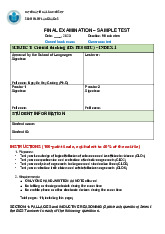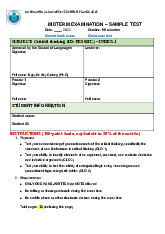













Preview text:
“He who defines the terms wins the argument” 2 Language 1 What is Language?
Language is a system of symbols for thinking and communicating.
Language is a tool we have been using to understand and develop our thinking. We have been: Language as a Tool Language is a powerful tool: To Clarify Thinking For Social Communication To Influence People 4
Learning about the thinking of others by reading
Expressing our own thinking through writing
Exchanging ideas with others by speaking and listening
Thought and language can contribute to clear, effective thinking and communication. 3 Clarify Thinking
Language represents your thoughts, feelings, and experiences symbolically “I know what I want to say, but
I just can’t find the right words.”
The relationship between thinking and language is interactive; both processes are
continuously influencing each other in many ways.
Clear and precise language leads to clear and precise thinking. 5 Clarify Thinking
Words are vague if they have fuzzy or inexact boundaries and hence give
rise to unclear borderline cases.
Words are over general if the information they provide is too broad and
unspecific in a given context. Examples: A: B, What is seven plus five B: More than two 8 Clarify Thinking
Vague language - using words that are very imprecise and general. Vague words
are words that lack a clear and distinct meaning.
A word (or group of words) is vague when its meaning is fuzzy, blurry, or inexact. Examples:
I had a nice time yesterday
That is an interesting book She is an old person She is a beautiful girl 7 Clarify Thinking
Ambiguous language - also interfere with the clear expression of thoughts. An
ambiguous word is a word with more than one (1) meaning that is open to different interpretations.
A word or expression is ambiguous if it has two or more distinct meanings and the
context does not make clear which meaning is intended. Examples: Sometimes words She went to the bank. have two meanings The duck is ready to eat
Flying planes can be dangerous 10
Mother: Where are you going? Teenager: Out
Mother: When will you be back? Teenager: later Overgenerality 9 Clarify Thinking
Here are some rules that can be adopted to achieve clear communication: Rules Types of definitions
Stipulative definitions: create a new words or used an old word in an entirely new way. 12
1. Tell listeners what you believe they want to hear 2. Don't tell listeners what they already know 3.
You should vary the style of your communication, depending on the knowledge, age and status of your listeners 4. Tell the truth 5.
Use a simple straightforward style 6.
Utilize manner and context to clarify meaning 11 Lexical Definitions
Lexical Definitions: a word is defined in the way it is standardly used in the
language. The purpose of a lexical definition is to state the conventional, dictionary meaning of a word. 14 Persuasive definitions
Persuasive definitions: arguer defines a term in an effort to persuade a reader
or listener to agree with the arguer’s point of view regarding the thing being defined 13 Strategies for defining
Ostensive Definitions: Simply pointing to, or demonstrating, the thing being defined.
Enumerative Definitions: providing specific examples of what the word
refers to EX: football player: means
Definitions by Subclass: A definition by assigns a meaning to a word by listing
subclasses of the general class to which the word refers.
EX: Mammal means gorilla, horse, lion, whale, and so forth. 16 Precising definitions
A precising definition is intended to make a vague word more precise so that
the word’s meaning is not left to the interpretation of the reader or listener.
EX: “A heavy smoker”, for purposes of this clinical trial, is anyone who smokes
more than twenty-four cigarettes per day. 15 Strategies for defining
Synonymous Definitions: assigns a meaning to a word by offering a synonym –
that is, another word that has approximately the same meaning as the word being defined.
Definition by Genus and Difference: assigns a meaning to a word by
identifying a general class (genus) to which things named by the word belong
and then specifying a differentiating quality (difference) that distinguishes
those things from all other things in the class. EX: buck means male deer Calf means young cow 18 Strategies for defining
Etymological definitions: tell what part of speech a word is, how it is
commonly pronounced, and whence it came. (Etymology = ancestry). EX: Automobile
Auto: from Greek, mean “self”
Mobile: from French, meen “move” 17
Rules for constructing good lexical definitions
Provide a context for ambiguous words.
Avoid slanted definitions (biases, emotionally charged
definitions) Avoid figurative definitions.
Avoid needlessly obscure definitions ( include a lot of big words or
technique jargon that readers aren’t likely to understand).
Avoid circular definitions: 20
Rules for constructing good lexical definitions
Don’t make the definition too broad or too narrow.
EX: A definition of automobile as “ a vehicle with four wheels” : too broad
EX: A definition of sibling as “ brother” : too narrow.
Convey the essential meaning of the words being defined.
EX: horse: the animal ridden by Napoleon during the battle of Waterloo: poor definition. 19 Social Communication
Language is always used in context.
We should use the language style that is appropriate to the social situation.
Language styles vary from informal to formal.
Language styles –used in a context. You always speak with a person in mind,
according to the situation. You may converse differently with friends, colleagues, parents and relatives. 22
The important of precise definitions
A convincing argument often depends on the clear and accurate definition of language.
The failure to define terms carefully can result in a messy battle with some
participants struggling to find the truth and others fighting to avoid it. 21 Social Communication Remember Influence People The intimate relationship between language and thinking makes it
natural that people use language to influence the thinking of others.
Two types of language are often used to promote the uncritical acceptance of viewpoints: Euphemistic language Emotive Language
By developing insight into these language strategies, you will strengthen your abilities to function as a critical thinker. 24
The ability to think critically gives you the insight and the intellectual ability to:
Distinguish people’s language use from their individual qualities.
Correct inaccurate beliefs about people. Avoid stereotypical responses. 23 Influence People
Emotive Language - Language that would probably stimulate certain feelings in
you. Language that evokes feelings in others. - The emotional dimension of language. Example:
What is your immediate reaction to the following words: Ronaldo Freedom Terrorist Peaceful Democracy 26 Influence People
Euphemistic language - to speak with good words and involves substituting a
more pleasant way of saying something instead of a blunt way. Examples:
To disguise the unpleasantness of death, we could say: ‘She passed away’
‘She departed this life’ 25 References Influence People
Emotive language often plays a double role – it not only symbolizes and
expresses our feelings but also arouses or evokes feelings in others (E.g. “ I Love You!”)
The presence of emotive words is usually a sign that a personal opinion or
evaluation rather than a fact is being stated.
Emotive language usagecan bemisleading and even dangerous when
speakers do not identify their opinions as opinions because they want you
to treat their judgments as facts. 27
Document Outline
- Clarify Thinking
- Clarify Thinking (1)
- Rules
- Remember




